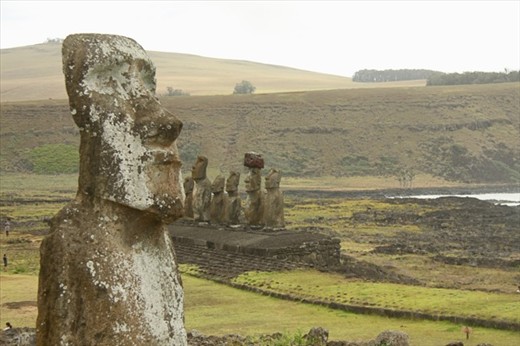Easter Island (Isla Pasqua in Spanish) is also known as Rapa Nui in the local language. It is the most remote inhabited island in the world, 2200 miles in the Pacific from mainland Chile and 2600 miles from Tahiti. Surprisingly, Rapa Nui is in the same time zone as New York. In fact, all of South America lies east of Miami. No kidding – look at a globe.

We joined forces with Niu, his wife Heung and kids Alan and Kevin, and rented a car to tour the island, rather than take one of the expensive tours. I drove the battered Chevy 4X4 pickup – Niu can’t drive a stick – while Alan and Kevin rode in the bed. Niu, an engineer, splits his time between Ohio and working in his native China. Heung is a math/science tutor in Canton. Kevin, 14, has caught the science bug and is hoping to study marine biology. Alan, a freshman at Purdue, wants a career in the Air Force and took to Connie right away. They are an interesting modern family and we hope to keep in touch with them for many years.

Explorer Thor Heyerdahl set out from Peru in his balsa raft to “prove” that the first Rapa Nuians came from South America. His successful voyage, recounted in Kon Tiki, put Easter Island on the map but new evidence favors adventurous sailors around 400 AD from the South Pacific islands. Today about 60,000 visitors fly in each year – no cruise ships on Easter Island – mainly to see the famous World Heritage “moais,” those iconic statues that look like aliens from another world. There are more than 800 moais scattered around the island, many still at the original quarry site where they were carved from the volcanic tufa, the oldest dating back to around 800. During the ensuing centuries most were upended by warring tribes or toppled by earthquakes and tsunamis. Today perhaps 50 statues have been re-erected in several locations, some wearing their “hats,” most facing west towards the setting equinox sun.

We were glad for the four-wheel drive once we got off the paved road. The rocky track along the cliffs is a great place to watch the power of the Pacific. Waves that had traveled thousands of miles crashed onto the volcanic rocks; spray showering fifty feet into the blue sky. Poor Alan and Kevin stuck it out in the back, sunburned and choking on the dust until a shower forced them to crowd into the cab. They got a chance to wash off at the white sand beach at Ahu Tau a Ure. We were planning to drive to some of the more remote places until I noticed a huge bubble on one of our tires. We all voted to return to Hanga Roa rather than risk a blowout on some remote dirt road.